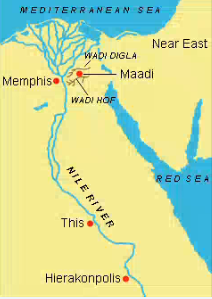题目解析:
【题目翻译】根据第4段,以下哪个不是孟菲斯被选为统一埃及首都的原因?
A:它位于一条主要贸易路线与尼罗河谷的交汇处。
B:它离土地很近,可以用来放牧和种植庄稼。
C:附近的洗衣粉丝们进入了可以用作沙漠贸易路线的洼地。
D:由于外国商人在附近的马迪定居,这两个城市之间的贸易可以建立。
【判定题型】:根据题干中出现的大写“EXCEPT”/"NOT" 等其他明显表示否定的词,可以判定本题为否定事实信息题,需要找出与原文信息不符的那个答案。
【关键词定位】:根据题干关键词“the capital of a united Egypt”,可以将出题范围锁定在 Passage 4。
【选项分析】
A 选项中,根据关键词“junction”定位到这一句“The foundation of the national capital at the junction of an important trade route with the Nile valley is not likely to have been accidental.” 综合第四段来看,控制埃及和近东地区之间的贸易路线,是埃及统治者们在国家刚建成时的当务之急,故 A 选项符合原文,排除。
B 选项对应第四段倒数1、2句话,这两句话说沙漠牧场和冲积耕地在该地区结合,所以 B 选项符合原文,排除。
C 选项对应第四段第2句“The two outwash fans in the area gave access to the extensive wadi systems of the eastern desert.” 故 C 选项符合原文,排除。
D 选项说外国商贩在马迪城附近定居,促进了两地的贸易。文中并未提及该信息,故 D 选项为正确答案。


 The city of Memphis, located on the Nile near the modern city of Cairo, was founded around 3100 B.C. as the first capital of a recently united Egypt. The choice of Memphis by Egypt's first kings reflects the site's strategic importance. First, and most obvious, the apex of the Nile River delta was a politically opportune location for the state's administrative center, standing between the united lands of Upper and Lower Egypt and offering ready access to both parts of the country. The older predynastic (pre-3100 B.C.) centers of power, This and Hierakonpolis, were too remote from the vast expanse of the delta, which had been incorporated into the unified state. Only a city within easy reach of both the Nile valley to the south and the more spread out, difficult terrain to the north could provide the necessary political control that the rulers of early dynastic Egypt (roughly 3000-2600 B.C.) required.
The city of Memphis, located on the Nile near the modern city of Cairo, was founded around 3100 B.C. as the first capital of a recently united Egypt. The choice of Memphis by Egypt's first kings reflects the site's strategic importance. First, and most obvious, the apex of the Nile River delta was a politically opportune location for the state's administrative center, standing between the united lands of Upper and Lower Egypt and offering ready access to both parts of the country. The older predynastic (pre-3100 B.C.) centers of power, This and Hierakonpolis, were too remote from the vast expanse of the delta, which had been incorporated into the unified state. Only a city within easy reach of both the Nile valley to the south and the more spread out, difficult terrain to the north could provide the necessary political control that the rulers of early dynastic Egypt (roughly 3000-2600 B.C.) required.